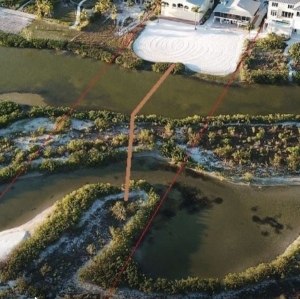The state of Florida has filed a motion for Summary Judgment in the Fort Myers Beach dune walkover case. A motion for summary judgment is a tool used to end a lawsuit early, when the defendant believes the deciding factors in a case are based strictly on fact and no determination of the law is required.
A motion for summary judgement is not an unusual move in court cases. If the judge agrees with the state, this conflict could end soon.
Last year, Estero Boulevard homeowners Eddie Rood and Kurt Kroemer filed a Quiet Title lawsuit against the State claiming they own the land behind their homes. Rood and Kroemer have surveys by a Florida certified surveyor showing the land is part of their deeded lots. The land in dispute contains the boundaries of the Critical Wildlife Area, which is protected land used by the FWC to protect endangered bird species.
The suit was filed after the town denied the homeowners a permit for a dune walkover so they could get to the beach from their homes. The town denied the request due to the proximity of the walkover to the CWA.
The town of Fort Myers Beach town council is watching this case closely. If Rood and Kroemer win the case against the state, and the town does not approve the dune walkover, the homeowners plan to file a Bert Harris lawsuit against the town, claiming their homes are worth less without direct access to the beach. They had access until a neighbor blocked the access path around the lagoon. Rood also filed an ADA lawsuit against the town over the walkover.
In the Motion for Summary Judgment, the State references a new document, “The Morphological Evolution of Little Estero Island” dated May 2022 and created by Ralph Clark P.E., an employee of the FDEP as a Coastal Engineer. In the document, Clark creates a timeline using past aerial photographs going back to 1968. The timeline shows the creation and evolution of the Little Estero Island, a barrier reef, which grew off the coast of FMB in the late 1960 and early 1970’s.
The State claimed ownership of Little Estero Island in 1981, and since then, claims the island has grown by accretion and grew down the coast for almost a mile. The State claims, due to tidal activity, the island connected to the beach, and thus remains in State ownership.
Attorneys for Rood and Kroemer say they plan to respond to the Summary Judgement motion.
If the judge agrees with the State, no trial will be needed, and the CWA ownership is proved to be owned by the State. If the judge denies the motion, it could mean that all the States facts in this case are not true, and the CWA could lose its designation.
Currently, there is no set time for the judge’s decision to this Motion.


Comments are closed.